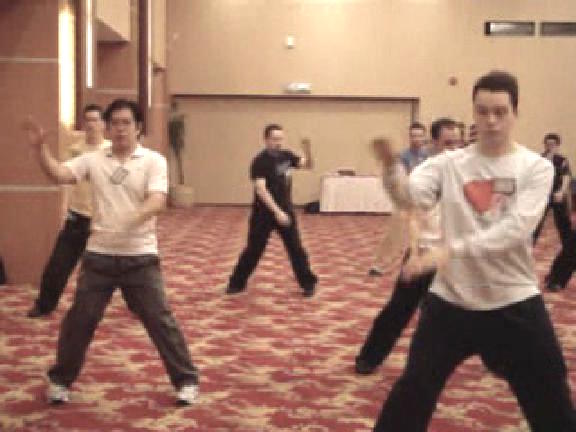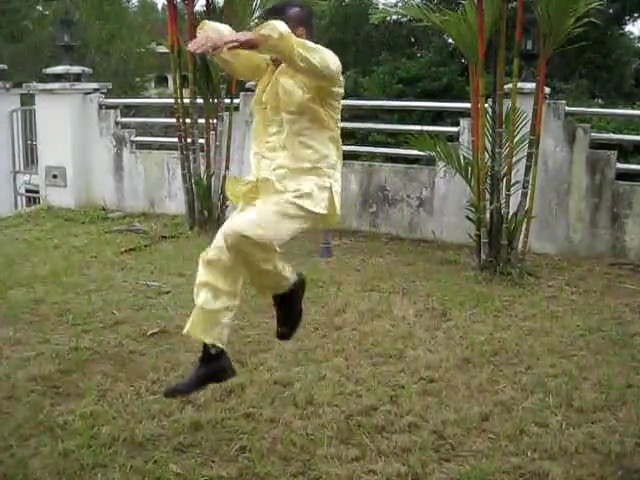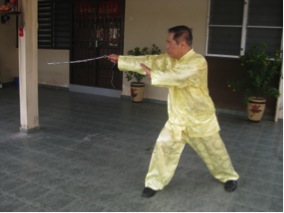HOW SIMILAR IS CHOE FAMILY WING CHOON TO THE ORIGINAL STYLE TAUGHT BY YIM WING CHOON?

Siu Lin Tou of Choe Family Wing Choon Kungfu
Question 8
How similar do you estimate the Choe Family Wing Choon practiced in our school to be to the original style taught by Yim Wing Choon?
Sifu Andy Cusick
Answer
I believe that the Choe Family Wing Choon practiced in our school is very similar to the original style taught by Yim Wing Choon, with the exception of the part contributed by Choy-Li-Fatt Kungfu. On the other hand, considering only the Wing Choon part and leaving out the Choy-Li-Fatt part, Choe Family Wing Choon is still very different from the style of Wing Choon most popularly practice today.
A brief historical background will explain the Choy-Li-Fatt part of Choe Family Wing Choon.
Choe Family Wing Choon was originally an exclusive art taught only to the Choe Family in the Nga Wu Village of Phoon Yu District of Guangdong in South China. “Nga Wu” means “Beautiful Lake”. “Phoon Yu” is just the name of the district without any special meaning.
Initially the villages of Nga Wu practiced Choy-Li-Fatt Kungfu, taught by a famous master, Yik Kam. One day a red-boat, i.e. a huge boat conveying actors and apparatus of Cantonese opera, landed at Nga Wu Village. One of the actors, Leong Yi Tai, was a master of a little-known kungfu style called Wing Choon Kungfu.
Yik Kam, who was keen to meet other kungfu masters, paid a visit to Leong Yi Tai and requested a friendly sparring. Yik Kam was so convincingly beaten by Leong Yi Tai that he begged the Wing Choon master to accept him as a disciple.
Subsequently Yik Kam taught Wing Choon Kungfu in Nga Wu Village, but he kept the famous Drunken Eight Immortals set. He also composed his Choy-Li-Fatt techniques into a set, and just called it “Choy-Li-Fatt”.
There were many kungfu sets in Choe Family Wing Choon passed down by Yik Kam. The fundamental set, which all students must learn, was Siu Lin Tou, which incorporated the three sets of popular style Wing Choon, namely Siu Lim Tou, Cham Kiew and Phew Chee. The other Wing Choon sets included Flower Set, Tiger-Crane, Battle-Palm, Battle-Fist and Essence of Fighting.
Although Battle-Palm and Battle-Fist were Wing Choon sets, there were a lot of Choy-Li-Fatt features in them. My sifu, Sifu Choe Hoong Choy, told me that their spirit was Wing Choon, but their application was Choy-Li-Fatt. Essence of Fighting had a combination of Wing Choon and Choy-Li-Fatt. It was probably composed by Yik Kam, drawing from the best techniques he had used in his fighting.
Flower-Set and Tiger-Crane were typically Southern Shaolin Kungfu, with emphasis on the softer forms of the snake and the crane. Siu Lin Tou was like popular style Wing Choon, except that the ginger-fist (also called the leopard fist), the phoenix-eye fist as well as the bow-arrow stance were frequently used.
I once asked my sifu why our fundamental set was called "Siu Lin Tou", which means "Little-Practice-Beginning", whereas the fundamental set of popular style Wing Choon was called "Siu Lim Tou", which means "Little-Thought-Beginning". My sifu said that every time Yim Wing Choon practiced her kungfu, that was the set she would begin first before proceeding to other practices. Hence, the set came to be called “Siu Lin Tou”, or “Little-Practice-Beginning”.
My sifu did not know why in popular style Wing Choon the set was called "Siu Lim Tou". But he was of the opinion that as "Siu Lin Tou" required more effort to pronounce, gradually it changed to "Siu Lim Tou", which would be smoother to pronounce, as in some English words like "thank you" and "come on".
Besides the Long Stsff and the Butterfly Knives which were found in popular style Wing Choon, there were also many weapon sets in Choe Family Wing Choon which were not found in popular style Wing Choon. These weapon sets included the sabre, the short staff, the big trident, the soft whip, the spear, the kungfu bench and the Guan Dao.
I believe that the Wing Choon part of Choe Family Wing Choon, like Siu Lin Tou, Flower Set and Tiger-Crane was similar to what Yim Wing Choon practiced and later taught to her husband, Leong Phok Khau. Leong Phok Khau taught Wing Choon Kungfu to two disciples, Wong Wah Poh and Leong Yi Tai.
Leong Yi Tai taught the art to Yik Kam, whose successor was Choe Shun, who passed the art to Choe Tuck Seng, then to Choe Chun, and then to Choe On. Choe On taught my sifu, Choe Hoong Choy.
My opinion that Choe Family Wing Choon was similar to the art taught by Wing Yim Choon was based on some research. It is well known in kungfu circles that the specialty of Ng Mui, Yim Wing Choon’s teacher, was the Flower Set. Ng Mui taught the set to her two disciples, Yim Wing Choon and Fong Sai Yoke. It was from the Flower Set that Yim Wing Choon evolved her Wing Choon Kungfu.
When I was the Honorary Secretary of the Kedah Kungfu and Lion Dance Association in the 1980s, I spent quite some time with a Ng Mui Kungfu master. He showed me some of his favorite kungfu moves and I noticed how similar they were with those of Choe Family Wing Choon.
Another of Ng Mui favorite kungfu set was Tiger-Crane. She also taught this set to her two disciples, Yim Wing Choon and Foong Sai Yoke. I learned this Tiger-Crane Set from Sifu Choe Hoong Choy. This Tiger-Crane Set was different from the Tiger-Crane Set I learned from Uncle Righteousness, and also different from the one of Wong Fei Hoong’s lineage.
One of the patterns, Single Leg Flying Crane, was an ultimate technique of the Ng Mui Kungfu master. He told me that no one had managed to escape this ultimate of his. During a friendly sparring, he applied his ultimate technique on me. Luckily I knew about it from the Wing Choon Tiger-Crane Set, and thus was able to counter it.
These examples suggested that Yim Wing Choon practiced the Flower Set and the Tiger-Crane Set. But still it was possible that when she developed her Wing Choon Kungfu, she discarded these sets even though they were very useful. However, other evidence suggested that this was not so.

The deadly double flying kick of Choe Family Wing Choon
There were records that when Leong Chan, a disciple of Wong Wah Poh, fought he used kungfu techniques similar to those of Southern Shaolin, including bow-arrow stance, false-leg stance and palm strikes, for which he was famous, similar to those in Flower Set. His victorious fights won him the honorable nick-name, the Wing Choon Kungfu King.
There was an interesting description of his encounter with another kungfu masters famous for Iron Palm, but whose name I cannot remember. A tree branch was in their way while they were walking along a country path. The master broke the branch with his Iron Palm to clear the way, demonstrating his kungfu force.
Soon they came to the edge of a pond, where birds on a tree were making a lot of noise. Leong Chan use his palm strike to break a branch, causing the birds to fly away.
“Now we can have a nice chat undisturbed by the birds,” Leong Chan said.
“Your kungfu force is remarkable" the master replied.
“I have heard the fame of your Iron Palm. I had a chance to see it just now,” remarked the Wing Choon Kungfu King.
Once when Leong Chan was having his morning tea, he was ambushed by a group of about 15 people using weapons. He fought his way out using a bench.
Leong Chan’s favorite weapon was not a kungfu bench, but a soft whip. Once he attended a gathering, expecting that there would be a fight. So he hid his soft whip under his clothing. Sure enough a fight broke out and he was attacked by group of about 20 people with weapons. He fought his way out using his soft whip.
There was another interesting story connected with the patriarch of Choe Family Wing Choon. Although Leong Chan had been successful in all his fights, eventually he met another master whom he was not confident of beating. It was a leitai match, i.e. a match on a platform with no rules and open to public viewing. For many days Leong Chan brooded over how he could meet this master.
Then news came that a red-boat with his sisook, Leong Yi Tai, on it would land at Fatt San, or the Mountain of Buddhas, the city in South China where Leong Chan lived. Leong Chan visited his sisook on the boat and told him his predicarment.
“I know the fighting style of the master,” Leong Yi Tai said. “I’ll teach you a special technique to beat him.”
“I’m grateful for sisook’s teaching,” replied Leong Chan.
“But the red-boat is too public for me to show you the secret.”
Then Leong Yi Tai leaned over and whispered something into Leong Chan’s ear.
“I’ll show you the special technique in a fighting scene tonight.”
So that night Leong Chan went to the opera and looked out for the secret in a fighting scene. He got it. It was a double flying kick, known as “yin-yeong thui” in Cantonese, literally meaning “drake-duck kick”. It was an example of hiding secret in the open. This double flying kick was similar to the one the Ng Mui Kungfu master used on me.
Leong Chan practiced the technique for the remaining days until the leitai match. True enough he beat the master with this double-flying kick.
This event revealed the following facts which the uninitiated would be unable to detect, and which showed that our Choe Family Wing Choon was similar to the original style taught by Yim Wing Choon.
The double flying kick was found in the Flower Set and the Tiger-Crane Set but not in Siu Lin Tou, or the three fundamental sets of Siu Lim Tou, Cham Kiew and Phew Chee. Not only that Leong Chan had practiced the Flower Set and the Tiger-Crane Set, or at lease one of the two sets, but also that Leong Yi Tai knew about this fact.
If Leong Chan had not practiced the double flying kick before, even if Leong Yi Tai told him the secret, Leong Chan would not be in time to practice it well enough to defeat the master in the leitai match. If Leong Yi Tai had not known that Leong Chan had practiced the double flying kick, he would not have told him the secret as Leong Chan would not be able to use it effectively in practice though he might know the secret in theory.
As an analogy, if you had not known that your European friend going to England for a holiday had learnt driving before, you would not tell him that in England he had to drive on the left side of the road. Even if he knew this in theory, he would not have sufficient time to learn driving on the left side to put it into effective practice.
With some fun in detective work, we can rightly conclude that the Flower Set and the Tiger-Crane Set were taught by Yim Wing Choon to her husband, Leong Phok Khau, who in turn taught them to Wong Wah Poh and Leong Yi Tai. Wong Wah Poh taught it to Leong Chan, and Leong Yi Tai passed them on to our Choe Family Wing Choon lineage. Hence, the Choe Family Wong Choon practiced in our school is similar to the original style taught by Yim Wing Choon.

Leong Chan, known as Wing Choon Kungfu King, was famous for his soft-ship
The questions and answers are reproduced from the thread Wing Choon Kungfu -- 10 Questions to Grandmaster Wong in the Shaolin Wahnam Discussion Forum.
LINKS
